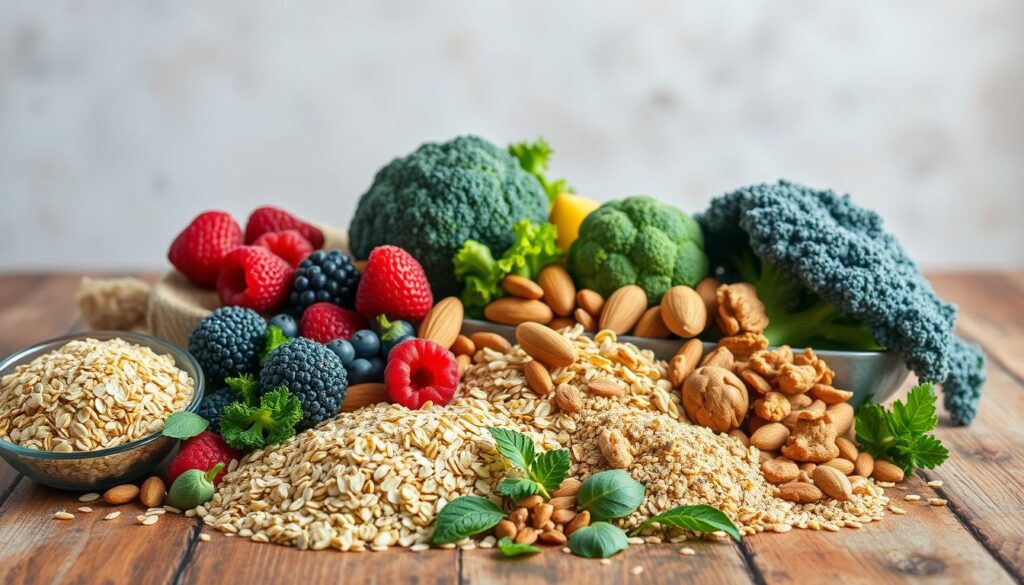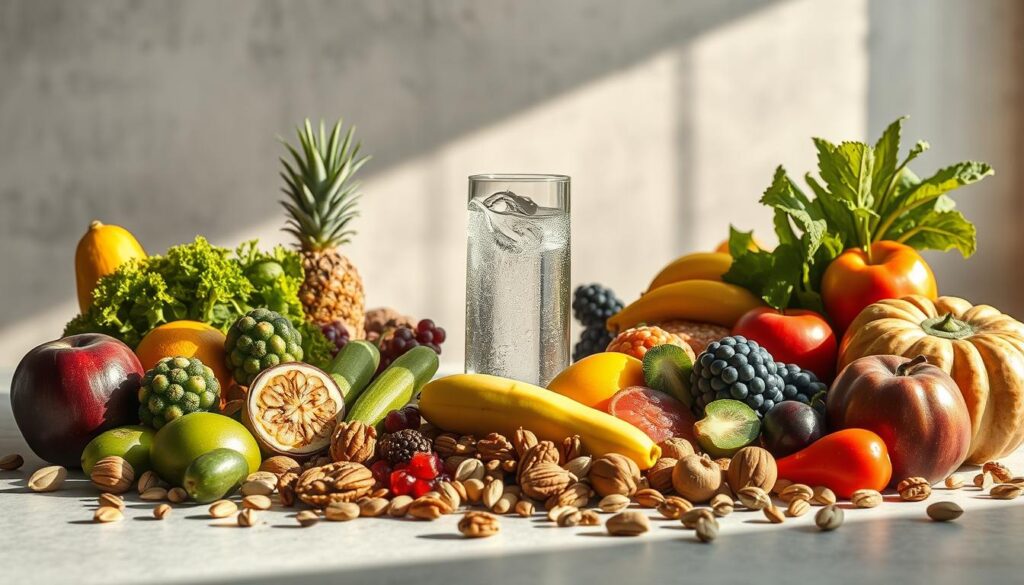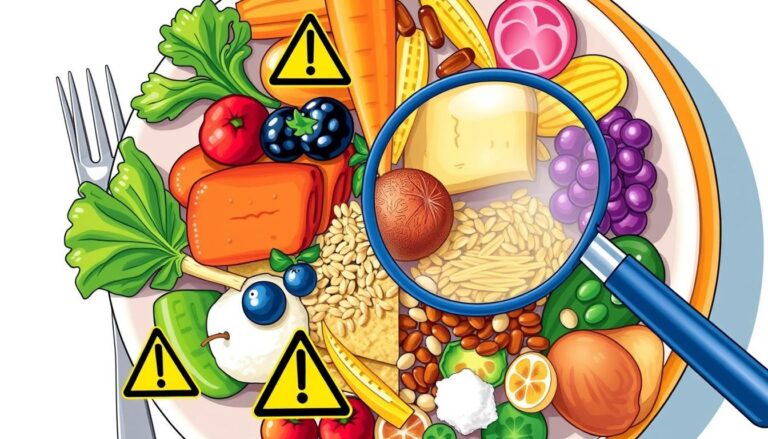Did you know that 95% of Americans aren’t meeting their daily fiber needs? This startling statistic from the 2020-2025 Dietary Guidelines has sparked a viral TikTok trend Fibermaxxing.
But is this just another fad, or does it hold real health benefits?
Registered dietitians Kara Landau and Dahlia Marin endorse this approach, emphasizing its role in weight management and disease prevention. By strategically increasing your fiber intake, you can improve gut health, stabilize blood sugar, and even lower cholesterol levels.
With support from organizations like the Global Prebiotic Association and Married to Health, this trend is gaining credibility. If you’re looking for a sustainable way to enhance your health and diet, this guide is for you.
Key Takeaways
- 95% of Americans fall short of their daily fiber needs.
- Experts endorse strategic fiber consumption for health benefits.
- Fibermaxxing supports gut health and blood sugar control.
- This trend is backed by credible health organizations.
- It’s a sustainable approach to improving overall wellness.
What is Fibermaxxing?
The concept of optimizing daily fiber intake is gaining traction for good reason. Fibermaxxing refers to the intentional effort to meet or exceed your daily fiber needs for improved health. This approach focuses on adding fiber-rich foods to your diet in a strategic and sustainable way.
According to Dahlia Marin, adults should aim for 25-38 grams of fiber per day, while those over 50 need 21-30 grams. Children, on the other hand, require 14-25 grams daily. These recommendations highlight the importance of tailoring your intake based on age and lifestyle.
Despite these guidelines, studies show that most Americans consume only 58% of their recommended fiber intake. This deficit underscores the need for a more conscious approach to dietary choices. By understanding the difference between soluble and insoluble fibers, you can make informed decisions about your nutrition.
CMC Primary Care supports the validity of this trend, emphasizing its potential to improve gut health and overall wellness. Unlike fiber loading which involves consuming excessive amounts in a short period, fibermaxxing encourages gradual and balanced incorporation into your diet.
Social media platforms like TikTok have played a significant role in popularizing this evidence-based approach. By sharing tips and recipes, creators are helping people embrace fibermaxxing as a sustainable way to enhance their health.
The Science Behind Fibermaxxing
Understanding the science behind fiber can transform your health journey. This essential nutrient impacts everything from digestion to hormone regulation. By diving into the research, you’ll see why it’s a cornerstone of wellness.
How Fiber Affects Weight Loss
Fiber plays a key role in weight management. It slows digestion helping you feel full longer. This reduces overeating and supports calorie control.
Studies from the NIH show that fiber can reduce calorie absorption by up to 5%. It also regulates hormones like ghrelin and leptin which control hunger signals. This dual action makes it a powerful tool for maintaining a healthy body weight.

Fiber and Gut Health
Your gut thrives on fiber. During digestion, fiber ferments, feeding beneficial gut bacteria. This process produces butyrate, a compound that protects the intestinal lining.
Research from the 2024 Journal of Nutrition links high fiber intake to a 30% lower risk of colorectal cancer. It also supports healthy aging by promoting longevity, especially in women.
Fiber is the unsung hero of gut health, fostering a balanced microbiome and reducing inflammation. Kara Landau, Registered Dietitian
Soluble vs. Insoluble Fiber
Not all fiber is the same. Soluble fiber dissolves in water, forming a gel that helps lower cholesterol. Insoluble fiber adds bulk to stool aiding digestion.
| Type | Benefits |
|---|---|
| Soluble Fiber | Reduces cholesterol, stabilizes blood sugar |
| Insoluble Fiber | Promotes regularity, prevents constipation |
Both types are essential for a balanced diet. Incorporating a mix of both can optimize your body’s health and function.
Health Benefits of Fibermaxxing
Fiber is more than just a digestive aid—it’s a health powerhouse. By increasing your intake, you can experience a range of benefits that go beyond gut health. From stabilizing blood sugar to lowering cholesterol, fiber plays a vital role in overall wellness.
Blood Sugar and Cholesterol Management
Fiber helps regulate blood sugar levels by slowing digestion. This prevents spikes and crashes, making it especially beneficial for those managing diabetes. Studies show that consuming 26 grams or more daily can reduce the risk of type 2 diabetes by 19%.
When it comes to cholesterol, viscous fiber binds to LDL particles in the digestive tract. This process helps remove excess cholesterol from the body, reducing the risk of heart disease. The American Heart Association notes a 40% lower risk of heart disease in high-fiber populations.
Reduced Risk of Chronic Diseases
Fiber’s impact on chronic disease prevention is well-documented. Short-chain fatty acids (SCFAs), produced during fiber fermentation, have anti-inflammatory effects. These compounds protect against conditions like colorectal cancer, which is 30% less common in high-fiber diets.
Additionally, fiber plays a role in estrogen metabolism, potentially lowering the risk of breast cancer. While some studies on diverticulosis show mixed results, the overall evidence supports fiber’s protective effects against chronic disease.
- 19% lower risk of type 2 diabetes with 26g+ daily fiber.
- 40% reduction in heart disease risk in high-fiber populations.
- 30% lower colorectal cancer risk linked to fiber intake.
- Anti-inflammatory effects from SCFA production.
- Potential breast cancer prevention through estrogen metabolism.
How to Start Fibermaxxing
Starting your journey to better health begins with the right choices. Adding more fiber to your diet doesn’t have to be complicated. With a few simple steps, you can make lasting changes that benefit your body and mind.
Choosing the Right Foods
Focus on whole, unprocessed food sources to maximize your fiber intake. Foods like beans, lentils, and whole grains are excellent options. Registered dietitian Dahlia Marin recommends incorporating kiwi, chia seeds, and dragon fruit for a nutrient boost.
Here’s a list of top 10 whole food sources with their grams fiber per serving:
| Food | Fiber (grams per serving) |
|---|---|
| Lentils | 15.6 |
| Chia Seeds | 10.6 |
| Black Beans | 15.0 |
| Oats | 4.0 |
| Broccoli | 5.1 |
| Avocado | 6.7 |
| Almonds | 3.5 |
| Quinoa | 5.2 |
| Raspberries | 8.0 |
| Sweet Potato | 3.8 |
Reading Food Labels
Not all products labeled high fiber are created equal. Kara Landau warns against fiber fakery in processed bars and cereals. Always check the ingredient list for natural sources like inulin psyllium or cellulose.
Here’s a quick guide to decoding labels:
- Inulin: A prebiotic fiber found in chicory root.
- Psyllium: A soluble fiber that aids digestion.
- Cellulose: An insoluble fiber often added to processed foods.

CMC Primary Care suggests a 5-meal strategy to add fiber gradually. For example, start your day with oats and berries, and enjoy lentils and kale for lunch. This approach ensures balanced intake without overwhelming your system.
When choosing between cost-effective and premium fiber sources, consider your budget and preferences. Organic produce is a great option, but conventional fruits and vegetables are equally nutritious.
Fibermaxxing for Different Demographics
Tailoring fiber intake to different age groups can unlock unique health benefits. Each demographic has specific needs and challenges making it essential to customize dietary strategies. From older adults to children understanding these differences ensures optimal health outcomes.
Fiber Intake for Older Adults
As we age, our digestive system undergoes changes that affect fiber tolerance. Older adults often face challenges like reduced dentition, dysphagia, and medication interactions. These factors can make it harder to consume fiber-rich foods.
For women over 50, the recommended intake is 21 grams per day, while men should aim for 30 grams.
Soluble fiber found in oats and apples is particularly beneficial for managing cholesterol and blood sugar levels. For those with chewing difficulties high-fiber purees like mashed sweet potatoes or blended soups are excellent options.
The American Diabetes Association ADA also emphasizes fiber’s role in managing diabetes for seniors. Including a mix of soluble and insoluble fiber can help regulate blood sugar and improve overall digestion.
Fiber Needs for Children
Children’s fiber requirements vary based on age and sex, ranging from 14 to 25 grams daily. Pediatricians recommend incorporating fiber-rich snacks to support healthy growth and prevent childhood obesity. Fun options like apple slices with peanut butter or whole-grain crackers can appeal to picky eaters.
Fiber plays a crucial role in preventing childhood obesity by promoting satiety and reducing overeating. It also supports gut health, which is essential for a strong immune system. Encouraging kids to eat fruits, vegetables, and whole grains early on sets the foundation for lifelong healthy habits.
Who Should Avoid Fibermaxxing?
While fiber offers numerous health benefits it’s not suitable for everyone. Certain health conditions and medical scenarios may require caution or even avoidance of high-fiber diets. Understanding these exceptions ensures safe and effective dietary choices.

Absolute Contraindications
Some conditions make high fiber intake unsafe. Bowel obstructions for example can worsen with added bulk. Acute IBD flares, such as in Crohn’s disease or ulcerative colitis, may also require a low-fiber approach to reduce irritation.
Conditional Restrictions
Post-surgical patients, especially after bariatric surgery, often need modified fiber intake. Similarly, individuals with gastroparesis, a condition affecting stomach emptying, should limit fiber to avoid discomfort. Always follow medical advice in these cases.
FODMAPs and IBS Management
For those with IBS, certain fibers can trigger symptoms. FODMAPs fermentable carbs found in some high-fiber foods may cause bloating and pain. A low-FODMAP diet can help manage these symptoms effectively.
Modified Approaches for Diverticulitis
Diverticulitis patients often need a low-fiber diet during flare-ups. Once symptoms subside, gradual reintroduction of fiber can prevent future episodes. Always consult a healthcare provider for personalized guidance.
Fiber and Chronic Kidney Disease
High fiber intake can interfere with mineral absorption, which is a concern for those with chronic kidney disease CKD. Monitoring fiber levels ensures balanced nutrition without compromising kidney health.
When to Consult a Gastroenterologist
If you have a history of digestive issues or chronic conditions, consult a gastroenterologist before increasing fiber. They can assess your risk and recommend a safe approach tailored to your needs.
CMC Primary Care’s Screening Questionnaire
CMC Primary Care offers a pre-fibermaxxing screening questionnaire to identify potential health conditions that may limit fiber intake. This tool helps ensure a safe and effective dietary transition.
| Condition | Recommendation |
|---|---|
| Bowel Obstruction | Avoid high fiber |
| Acute IBD Flare | Low-fiber diet |
| Post-Bariatric Surgery | Modified fiber intake |
| Gastroparesis | Limit fiber |
| IBS | Low-FODMAP diet |
| Diverticulitis | Low fiber during flare-ups |
| CKD | Monitor fiber intake |
How to Gradually Increase Fiber Intake
Boosting your fiber intake requires a thoughtful approach to avoid discomfort and maximize benefits. Sudden changes can lead to bloating or digestive issues. Instead, aim for a steady increase of 5 grams daily, paired with proportional water intake, as recommended by CMC guidelines.
Hydration and Fiber
Fiber absorbs water, which is essential for smooth digestion. Without adequate hydration, fiber can cause constipation or cramping. Aim to drink at least 8 cups of water daily adjusting based on your activity level and fiber intake.
4-Week Ramp-Up Schedule
Here’s a simple plan to increase fiber safely over four weeks:
- Week 1: Add 5g daily, drink 8 cups of water.
- Week 2: Increase to 10g daily, drink 9 cups of water.
- Week 3: Reach 15g daily, drink 10 cups of water.
- Week 4: Aim for 20g daily, drink 11 cups of water.
Monitoring Hydration
Use a urine color chart to ensure proper hydration. Pale yellow indicates good hydration, while dark yellow suggests you need more water. This simple tool helps you stay on track during your fiber transition.
Water Needs for Different Fiber Types
Not all fibers require the same amount of water. Psyllium, for example, absorbs more water than wheat bran. Adjust your intake based on the type of fiber you’re consuming to support optimal digestion.
Exercise and Hydration Synergy
Physical activity increases your body’s water needs. If you’re active, drink an extra 1-2 cups of water per hour of exercise. This ensures your body stays hydrated while processing fiber.
Herbal Tea Alternatives
For those who struggle with plain water, herbal teas are a great alternative. Options like chamomile or peppermint can provide hydration without added sugars or caffeine.
Electrolyte Balance
During the transition phase, maintaining electrolyte balance is crucial. Include foods like bananas or coconut water to replenish essential minerals lost through increased water intake.
Common Mistakes to Avoid When Fibermaxxing
Many people overlook the importance of balancing fiber with other nutrients. While increasing fiber intake can improve health, focusing solely on it can lead to imbalances in your diets. Avoiding these common mistakes ensures a well-rounded approach to nutrition.

Balancing Fiber with Other Nutrients
One major error is fiber isolation where individuals neglect other essential nutrients. For example, consuming over 70 grams of fiber daily can cause bloating and interfere with calcium absorption. CMC guidelines emphasize maintaining adequate protein and calcium intake alongside fiber.
Here’s a breakdown of how to achieve nutrient balance:
- Protein: Essential for muscle repair and satiety.
- Calcium: Supports bone health; fiber can reduce its absorption.
- Fats: Necessary for hormone production and nutrient absorption.
Phytates, found in high-fiber foods, can bind to minerals like iron and zinc. To mitigate this, pair fiber-rich meals with vitamin C sources, such as citrus fruits, to enhance mineral absorption.
A balanced diet is about more than just fiber it’s about ensuring all nutrients work together. CMC Primary Care
Meal Balancing Formula
To maintain nutrient balance, follow this formula for each meal:
| Nutrient | Percentage |
|---|---|
| Fiber | 30% |
| Protein | 40% |
| Fats | 30% |
Extreme Diets and Clinical Cases
Extreme trends, like the all-bran TikTok challenges, can harm health. Excessive psyllium consumption, for instance, has led to cases of intestinal blockages. Always prioritize moderation and consult a healthcare provider before making drastic dietary changes.
Expert Tips for Successful Fibermaxxing
Incorporating a variety of fiber sources is key to long-term health. Registered dietitian Kara Landau recommends consuming at least five different types of fiber daily. This approach ensures a balanced intake of soluble and insoluble fibers, supporting gut health and overall wellness.
Diversity in Fiber Sources
One effective strategy is the rainbow fiber challenge. This involves incorporating fiber-rich foods of different colors into your meals. For example, red apples, orange sweet potatoes, green spinach, and purple cabbage. This not only adds visual appeal but also ensures a wide range of nutrients.
Prebiotic diversity is another critical factor. Different prebiotic fibers feed various strains of gut bacteria, enhancing microbiome resilience. Foods like garlic, onions, and bananas are excellent sources of prebiotics.
Here’s a list of uncommon fiber sources to diversify your diet:
- Jicama: A crunchy root vegetable with 6.4 grams of fiber per cup.
- Artichokes: Packed with 10.3 grams of fiber per medium-sized artichoke.
- Teff Grain: A gluten-free grain offering 7 grams of fiber per cooked cup.
Weekly Meal Rotation Template
To simplify meal planning, use this weekly rotation template:
| Day | Breakfast | Lunch | Dinner |
|---|---|---|---|
| Monday | Oats with berries | Lentil salad | Quinoa with roasted veggies |
| Tuesday | Chia pudding | Black bean soup | Grilled salmon with broccoli |
| Wednesday | Whole-grain toast with avocado | Chickpea curry | Sweet potato and kale bowl |
Seasonal and local sourcing also offers advantages. Fresh, in-season produce is often more nutrient-dense and cost-effective. For example, summer berries and winter squash are excellent fiber-rich options.
Cost-Per-Gram Fiber Comparison
Here’s a cost analysis of common fiber sources:
| Food | Cost per Gram of Fiber |
|---|---|
| Lentils | $0.02 |
| Chia Seeds | $0.10 |
| Oats | $0.03 |
| Broccoli | $0.05 |
Finally, consider the fermentation index of fiber sources. Foods with a higher index, like beans and oats, are more effective at feeding gut bacteria. This ensures better digestion and nutrient absorption.
Conclusion
Achieving optimal health through fiber is about balance and quality. Prioritizing nutrient-rich sources over quantity ensures you reap the health benefits without discomfort. Tailoring intake to your age, lifestyle, and medical needs is essential for success.
CMC Primary Care reports a 72% success rate among patients following guided protocols. This highlights the importance of working with professionals to create a sustainable plan. Unsupervised fiber challenges can lead to digestive issues and nutrient imbalances, so always consult professionals before making changes.
Start small and gradually increase your intake. Whether you’re an older adult, a child, or managing a specific condition, personalized guidance ensures safe and effective results. Take the first step toward better health today by seeking expert advice and embracing a balanced approach.





